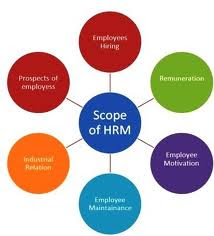Human resources are undoubtedly the key resources in an organization,
the easiest and the most difficult to manage! The objectives of the HRM
span right from the manpower needs assessment to management and
retention of the same. To this effect Human resource management is
responsible for effective designing and implementation of various
policies, procedures and programs. It is all about developing and
managing knowledge, skills, creativity, aptitude and talent and using
them optimally.
Human Resource Management is not just limited to manage and optimally exploit human intellect. It also focuses on managing physical and emotional capital of employees. Considering the intricacies involved, the scope of HRM is widening with every passing day. It covers but is not limited to HR planning, hiring (recruitment and selection), training and development, payroll management, rewards and recognitions, Industrial relations, grievance handling, legal procedures etc. In other words, we can say that it’s about developing and managing harmonious relationships at workplace and striking a balance between organizational goals and individual goals.
The scope of HRM is extensive and far-reaching. Therefore, it is very difficult to define it concisely. However, we may classify the same under following heads:
Human Resource Management is not just limited to manage and optimally exploit human intellect. It also focuses on managing physical and emotional capital of employees. Considering the intricacies involved, the scope of HRM is widening with every passing day. It covers but is not limited to HR planning, hiring (recruitment and selection), training and development, payroll management, rewards and recognitions, Industrial relations, grievance handling, legal procedures etc. In other words, we can say that it’s about developing and managing harmonious relationships at workplace and striking a balance between organizational goals and individual goals.
The scope of HRM is extensive and far-reaching. Therefore, it is very difficult to define it concisely. However, we may classify the same under following heads:
- HRM in Personnel Management: This is typically direct
manpower management that involves manpower planning, hiring (recruitment
and selection), training and development, induction and orientation,
transfer, promotion, compensation, layoff and retrenchment, employee
productivity. The overall objective here is to ascertain individual
growth, development and effectiveness which indirectly contribute to
organizational development.
It also includes performance appraisal, developing new skills,
disbursement of wages, incentives, allowances, traveling policies and
procedures and other related courses of actions.
- HRM in Employee Welfare: This particular aspect
of HRM deals with working conditions and amenities at workplace. This
includes a wide array of responsibilities and services such as safety
services, health services, welfare funds, social security and medical
services. It also covers appointment of safety officers, making the
environment worth working, eliminating workplace hazards, support by top
management, job safety, safeguarding machinery, cleanliness, proper
ventilation and lighting, sanitation, medical care, sickness benefits,
employment injury benefits, personal injury benefits, maternity
benefits, unemployment benefits and family benefits.
It also relates to supervision, employee counseling, establishing
harmonious relationships with employees, education and training.
Employee welfare is about determining employees’ real needs and
fulfilling them with active participation of both management and
employees. In addition to this, it also takes care of canteen
facilities, crèches, rest and lunch rooms, housing, transport, medical
assistance, education, health and safety, recreation facilities, etc.
- HRM in Industrial Relations: Since it is a highly
sensitive area, it needs careful interactions with labor or employee
unions, addressing their grievances and settling the disputes
effectively in order to maintain peace and harmony in the organization.
It is the art and science of understanding the employment
(union-management) relations, joint consultation, disciplinary
procedures, solving problems with mutual efforts, understanding human
behavior and maintaining work relations, collective bargaining and
settlement of disputes.
The main aim is to safeguarding the interest of employees by securing
the highest level of understanding to the extent that does not leave a
negative impact on organization. It is about establishing, growing and
promoting industrial democracy to safeguard the interests of both
employees and management.



